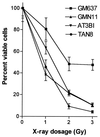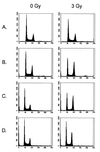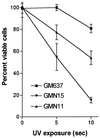Protein kinase mutants of human ATR increase sensitivity to UV and ionizing radiation and abrogate cell cycle checkpoint control
- PMID: 9636169
- PMCID: PMC22645
- DOI: 10.1073/pnas.95.13.7445
Protein kinase mutants of human ATR increase sensitivity to UV and ionizing radiation and abrogate cell cycle checkpoint control
Abstract
In fission yeast, the rad3 gene product plays a critical role in sensing DNA structure defects and activating damage response pathways. A structural homologue of rad3 in humans (ATR) has been identified based on sequence similarity in the protein kinase domain. General information regarding ATR expression, protein kinase activity, and cellular localization is known, but its function in human cells remains undetermined. In the current study, the ATR protein was examined by gel filtration of protein extracts and was found to exist predominantly as part of a large protein complex. A kinase-inactivated form of the ATR gene was prepared by site-directed mutagenesis and was used in transfection experiments to probe the function of this complex. Introduction of this kinase-dead ATR into a normal fibroblast cell line, an ATM-deficient fibroblast line derived from a patient with ataxia-telangiectasia, or a p53 mutant cell line all resulted in significant losses in cell viability. Clones expressing the kinase-dead ATR displayed increased sensitivity to x-rays and UV and a loss of checkpoint control. We conclude that ATR functions as a critical part of a protein complex that mediates responses to ionizing and UV radiation in human cells. These responses include effects on cell viability and cell cycle checkpoint control.
Figures





References
Publication types
MeSH terms
Substances
Grants and funding
LinkOut - more resources
Full Text Sources
Other Literature Sources
Molecular Biology Databases
Research Materials
Miscellaneous

